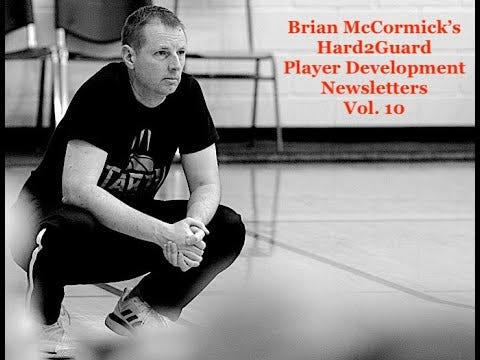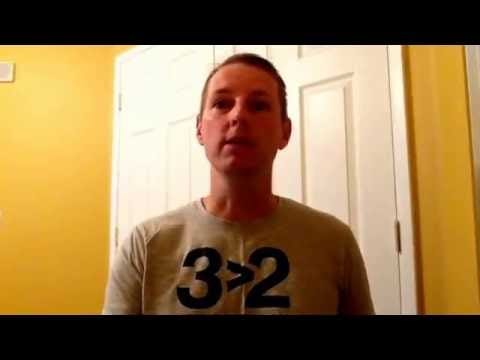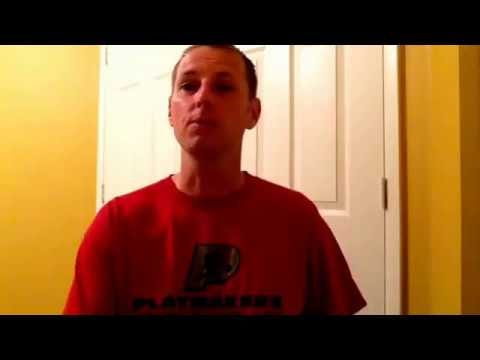Notes from a Shooting Clinic
Movement, Intention, and Decisions.
Our club organized another small clinic for the club’s youth coaches, and I was asked to present on shooting development. Below are the notes with some added explanations from the clinic.
The video above is far more detailed, and most of the ideas are derived from Evolution of 180 Shooter: A 21st Century Guide.
Rarely does anyone coach a pure beginner. Every player arrives with some previous experiences, instructions, successes, failures, and perceptions. These may be formal or informal, but nearly every player has shot a basketball before arriving for his or her first organized basketball practice. Therefore, teaching shooting, even with very young players, involves a change in an established habit.
The three biggest deficiencies I see lately in shooting development are movement skills, practice intention, and decision-making.
Technical skills (shooting) develop atop athletic skills (balance, coordination, deceleration, etc). I speak with our strength and conditioning coach almost weekly about adding something to their workouts (weight room and dynamic warmups) to address some athletic deficiency, which I see affecting their shooting despite good general strength and above-average vertical jumps.
Coordination, not strength is generally the more prevalent rate limiter. “Light and easy movements are good ones, as a rule,” wrote Moshe Feldenkrais in Awareness through Movement. A good shot has rhythm.
We added Olympic lifts (power cleans, push press) to internalize proper bending and explosive extending as used in shooting. “The muscles of the limbs are intended to direct their movements accurately, while the main power of the pelvic muscles is conducted through the bones of the limbs to the point at which it is required to operate. In a well-organized body work done by the large muscles is passed on to its final destination through the bones by weaker muscles, but without losing much of its power on the way,” wrote Feldenkrais. I use medicine balls occasionally in shooting workouts to add specificity with these movements. Exaggeration (through the added weight) is one method to help players feel a new movement or to exaggerate a mistake in order for them to perceive the problem on their own.
Lately, our focus has shifted toward deceleration, foot contacts, and posture for most, whereas overall coordination remains the rate limiter for a few. Shot-specific instruction, feedback, and repetitions will not produce big improvements as long as the athletic skills that underlie these movements remain suboptimal.
Next, players believe work or more automatically causes improvement; just being in the gym is enough. Players need a purpose for their practice (as always, their purpose may be fun, exercise, or another purpose; that is not wrong, but also not what I am writing about). They need the proper intention to improve. Players whose shots are uncoordinated and leaking power because their movement is too slow will not improve by shooting more with this slow, uncoordinated movement. Every repetition needs the intention to shoot faster and faster, to solve the coordination problem and eliminate the leaks. “Every time you/re on the court, you’re either practicing good habits or developing bad habits.”
Finally, most drills focus on repetitions, not the decision to shoot. The first part of a shot is the decision; players decide to shoot. Decisions affect shooting, just as with any skill. A simple choice reaction drill — if I say “One” you shoot; if I say “Two” you drive — is not decision-making; it is following coded directions. There is a cognitive aspect, as the player associates one with shooting as opposed to driving, but the coach drives the decision. A proper game-like shooting drill must involve defense and a passing option: The decision must be similar to the one made in a game.
Contested shooting drills are not the same as game-like or decision-making drills. We use contested shooting drills too, just as we use some unopposed drills. My point is these are not sufficient. Players need game-like decisions included in some drills too.
Performance improvements are multifactorial. We imagine shooting improvement derives from technique work, but players can improve by becoming better shooters or shooting better shots. There are athletic, emotional, psychological, social, tactical, and technical aspects to shooting, and improvements in one area should improve overall shooting. Shooting is more than the elbow and the follow through, but involves shot selection, shot creation, confidence, technique, footwork, and more. Some players improve without ever thinking about their shot-specific technique.
The environment affects shooting development and performance. Is the environment expanding or limiting? Both can lead to performance improvements. Limiting a player to stationary corner three-point attempts may improve his overall shooting percentages, which is one type of performance improvement. Increasing a player’s shot creation skills and encouraging him to shoot off-the-dribble three-point attempts may not increase his shooting percentages initially, but is another type of performance improvement.
Players have different capacities and are in different developmental stages, and therefore have different needs in terms of feedback, goals, and practice. With youth players, coaches should err toward some initial success with the youngest players and beginners, then expand skill sets before limiting them again as players reach more competitive and specialized levels. My players tend to improve as shooters because I do not tell them not to shoot even when limiting our three-point attempts to two or three players likely would improve our winning percentage.
My primary concentration with regards to technique is the beginning and the end: When players start from a good position and posture and end in a good position, the middle tends to take care of itself. Hand placement on the ball tends to influence the ball path, shoulders, elbow, and more. Deceleration tends to influence the stance, as well as the finish. Stopping in a balanced position or learning to use the rotation from the deceleration to accentuate the technique is important to shooting success. During unopposed shooting drills, I watch only the feet and can predict the shot’s success with above-average accuracy. If a shooter does not start well, the rest of the shooting motion must compensate. Some players excel at these compensations; most shooters need to improve their shot’s foundation to make a big leap forward in their shooting success, whether in terms of shooting percentages or ability to take and make more difficult shots.
Many coaches offer too much feedback too quickly. They strive to demonstrate their knowledge, analytical skills, or creativity rather than meeting the players’ needs. They prevent the players’ explorations and experimentation. They want immediate changes, not long-term, sustained success.
Change is hard. Players have their own perceptions, and their habits feel comfortable and correct. Often, instructions and feedback are insufficient to induce changes, as players quickly backslide to old habits. Perturbing their habits with specific exercises often prevents the the relapse to their habitual techniques.
An iPhone is the most important tool in coaching now, as I record a few shots and show players frame by frame what they look like. I rarely offer more than the picture or video, as the problem becomes obvious when they can see themselves. Sometimes, I ask a simple question, such as: Does that look like a good athletic position? Still images can be deceiving, but they also can highlight mistakes or potential mistakes. Regardless, the images further their understanding. They easily see for themselves what would take me dozens of words and attempts to get them to understand with solely verbal feedback. The video creates the intention, and they can attempt simple changes without requiring constant coach feedback.






